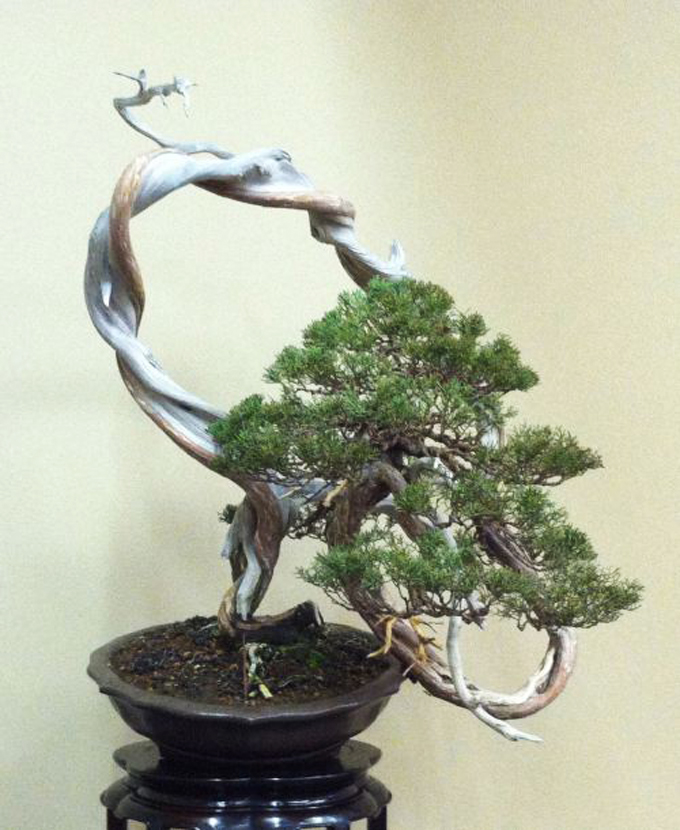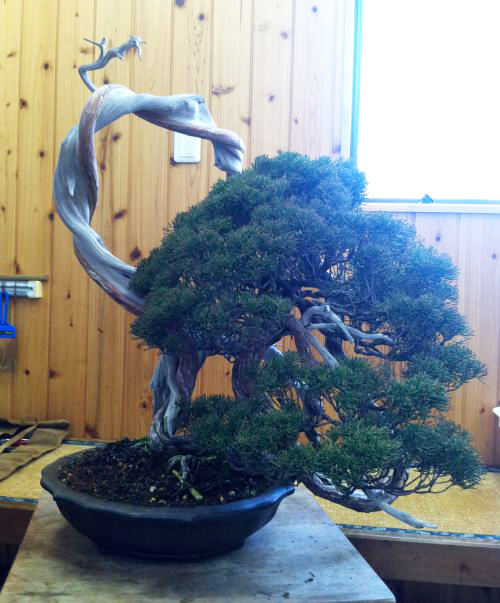 After Michael Hagedorn’s expert touch (the before photo is below). This photo is from Michael’s latest post which is about his trip to Japan to visit his teacher and the famous Kokufu Bonsai Exhibition.
After Michael Hagedorn’s expert touch (the before photo is below). This photo is from Michael’s latest post which is about his trip to Japan to visit his teacher and the famous Kokufu Bonsai Exhibition.
I’ve taken the liberty of combining pieces from three of Michael Hagedorn’s Crataegus Bonsai posts: His two latest posts from his recent visit to Japan and an an older post about Turface and Bonsai Soil.
One of the many positives about visiting Crataegus Bonsai is that I always learn something. There’s more than just learning for sure, including great trees, Michael’s personable easy-to-read writing style and his positive attitude about bonsai and life (even when he’s slamming Turface). But in this case it’s mostly about learning.
First, there are Michael’s comments about Turface, a common component in many bonsai soils (he doesn’t like it and he carefully explains why). The post is titled Life Without Turface and like pretty much everything on Crataegus, it’s worthwhile read (as is Michael’s excellent book: Post-Dated – The Schooling of an Irreverent Bonsai Monk).
Second, and still on the topic of soil, there’s a great new word that Michael uses. A word that, at least for the moment, added pleasure and even a glimpse of enlightenment to my life. It’s Hydrophobia (fear of water). At first I thought it was Michael’s clever invention (he’s fully capable) but no, it’s a real word and it’s a good one: “In chemistry, hydrophobicity (from the Attic Greek hydro, meaning water, and phobos, meaning fear) is the physical property of a molecule (known as a hydrophobe) that is repelled from a mass of water” from Wikipedia.
At this point, you may be thinking that this post is another shameless attempt to promote a couple of our products. And you’d be right. However and in spite of perceived motives, there’s some very useful information here (courtesy of Michael Hagedorn) and a couple photos of a great tree (also courtesy of Michael Hagedorn). BTW: the use of Michael’s photos and writings should not be construed as an endorsement of our Masters Bonsai Soil (though he does love pumice).
 Before. Here’s Michael’s caption about part of his Japan trip: ” I worked on four trees in the five and a half days I was not shoveling… this was the first. I’ll post the reworked tree in the next post.” (it’s at the top of this post).
Before. Here’s Michael’s caption about part of his Japan trip: ” I worked on four trees in the five and a half days I was not shoveling… this was the first. I’ll post the reworked tree in the next post.” (it’s at the top of this post).
 Two gallons worth of our lava and pumice Masters Bonsai Soil (in a 2 1/2 gallon bag). Below is a more or less readable version of the text on the label.
Two gallons worth of our lava and pumice Masters Bonsai Soil (in a 2 1/2 gallon bag). Below is a more or less readable version of the text on the label.

Great tree!
As for the debate on Turface, I’m one of those who has never experienced any problems that I could blame on it. It seems to me that we have to keep in mind that what works well for grower A may not work well for grower B — and vice versa — because of differences in climate, personal habits of watering, and a number of other factors. A one-size-fits-all approach is not optimal (any more than in healthcare!)
Wayne,
I know it’s not your fault but here we go again. Pall says turface yes and Hagedorn says turface no. I highly respect both of them but who’s right. I agree with Steve Moore, stick with what works for you. Geez!
As Ryan Neil said at our last bonsai club meeting, watering is the most important skill to have in bonsai. Regardless of the soil you use, you need to know how to water it!
I have used Turface as a soil component for years with good results. It is 25 percent of what I call my basic mix.
There is a lengthy article in this months ABS newsletter condemning Turface and I just don’t get it. It doesn’t create dry pockets unless you don’t mix your components to begin with. I still consider it a relatively inexpensive and viable soil component.
Sometimes I surface treat my better trees with Turface. It’s color sets of the moss nicely and when wet is a nice earthy color with small particle size.
Like many others I have used Turface going on twenty years. I have never experienced “dry pockets” but then again as others have stated if you mix your soil well it should not happen. My only issue with Turface over the past few years is the particle size seems to be getting smaller. As I typically sift all my components and I now loose about 12-15 pounds out of a 50 pound bag. Unfortunately the major users of this product (sports fields) are requesting the smaller granular size, and the bonsai community is such a small percentage of users that our needs are not considered. If the granular size was larger, it would be a hard product to beat for the price.
I guess the comment I sent yesterday didn’t register, so I’m commenting again. The turface dry spots that Michael Hagedorn refers to can occur from top watering. When turface is watered by soaking it becomes one of the wettest soil amendments. I have studied the hydration of many soil amendments, and water soaked turface has a water retention of 2-3 weeks after which it becomes bone dry. And the measured water holding capacity is 99 cc. H2O/ 100 cc. mass volume. Sorbing 100% of its mass is what the manufacturers also claim. So turface should not be dismissed based on its hydration properties, which can depend on how one waters the soil among other factors.
Thanks for all the turface experience and views.
FYI I’m not necessarily taking sides for or against Turface or other soil ingredients and mixes.
However, I do have a lot of respect for Michael Hagedorn and pay attention to what he has to say.
The rest is up to you.